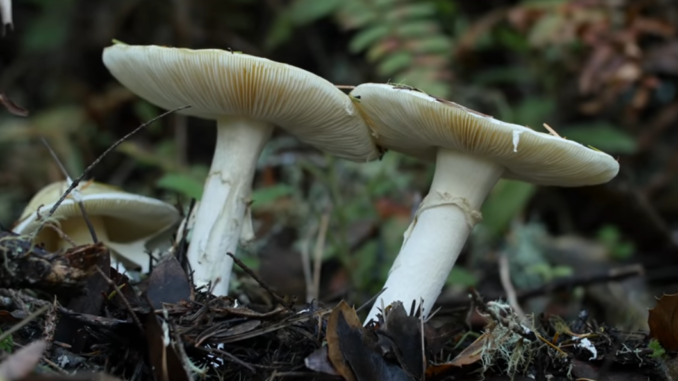
Amanita phalloides (common names: “deathcap”, “death cap”, “stinking amanita”, “deadly amanita”) is one of the most, if not the most, toxic mushrooms known to humans. Until relatively recent times, the species was found only on Europe, where it’s widespread. Unfortunately, this invasive fungus has made its way to North America, South America, New Zealand, and parts of Africa, Australia, and west Asia.
A. phalloides hitched a ride from Europe to the United States and Canada from the late nineteenth century on, bundled within the root ball of imported chestnut trees and most probably other plants as well. Another way the invasive fungus is migrating is in imported potting soil. If you see any mushroom popping up in a pot of dirt, it’s possible the fungus was already in the soil when purchased from a retailer. However, once established in the ground, say along with the roots of a transplanted tree, the fungus grows and spreads sight unseen until a mushroom pops up out of the earth.
Scientific Classification
Kingdom: Fungi
Division: Basidiomycota
Class: Agaricomycetes
Order: Agaricales
Family: Amanitaceae
Genus: Amanita
Species: Amanita phalloides (Link 1833)
Amatoxin poisoning is what happens when someone eats a toxic mushroom of the Amanitaceae family (genus: Amanita). Once the deathcap is digested (but not until then), the toxin takes effect. Typically, six or more hours pass after eating before you start feeling a pain in your guts. Extreme vomiting and diarrhea begin soon after. Amatoxin poisoning attacks your organs, with the liver and kidneys shutting down sometime after 72 hours, post-ingestion. Even if the dose is fatal, however, it could be an excruciatingly painful week or more before death occurs. Children and pets are especially vulnerable to catastrophic poisoning, so keep them away from any fungus that looks suspicious.
It’s important to understand that the deathcap’s toxicity is not altered by processing or preparation, either by cooking, drying, freezing, or heating. It’s just as deadly after preparation as it was raw. Although highly lethal to humans, cats, dogs, and other animals, it’s not toxic to many other critters and you might see bites taken out of a deathcap in the forest: that does not mean it’s safe to eat! Gathering wild mushrooms to eat is extremely dangerous for all but highly experienced mushroom experts.
Watch the first two videos for the crux of the matter. If after watching the short videos, respect for deathcaps continues to elude you, the third video might likely give you nightmares.
“Death-Cap Mushrooms Are Terrifying and Unstoppable” (2:35)
“This Mushroom Starts Killing You Before You Even Realize It | Deep Look” (3:47)
“The Deathcap (Amanita phalloides)” (19:33)
Question Of The Night: What makes you feel young?
